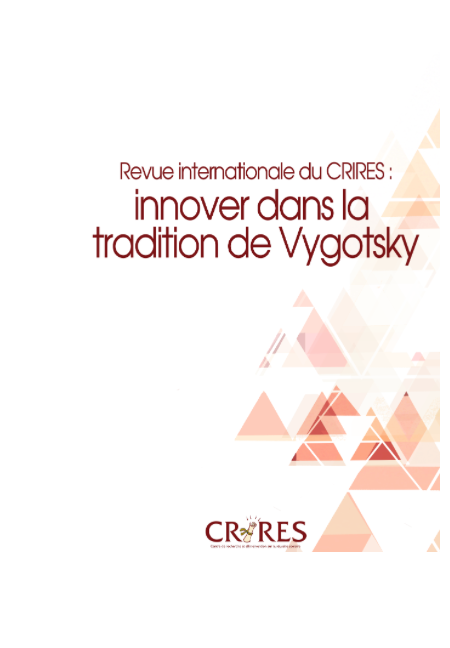Processus d’intégration du microordinateur XO dans une école primaire gabonaise : analyse sous l’angle de la théorie de l’activité
DOI:
https://doi.org/10.51657/ric.v1i1.41020Keywords:
ICT integration, OLPC, XO laptop, Pedagogical innovation, ImpactAbstract
This study aims to understand and illustrate the process of integrating the XO in a primary school in Libreville, Gabon. Conducted from the standpoint of Cultural Historic Activity Theory (CHAT), it leads to intrasystemic tensions induced by the lack of openness of the teachers' activity system towards tools not recommended by the official curriculum, and intersystemic tensions caused by the weakening of borders on the fringe of activity systems involved in student development in context. While intrasystemic tensions tend to begin expanding the integration of XO activity, intersystemic tensions lead instead to a "paralysis" to the point where it was difficult for teachers to make sense of a use of the XO driven by a motivation to change their classroom practice.
References
Barma, S. (2011). Analyse d’une démarche de transformation de pratique en sciences dans le cadre du nouveau programme de formation pour le secondaire, à la lumière de la théorie de l’activité. Revue canadienne de l’éducation, 33(4), 677-710.
Cristia, J., Ibarraran, P., Cueto, S., Santiago, A., et Severin, E. (2012). Technology and Child Development: Evidence from the One Laptop Per Child Program (No. IDB-WP-304). Inter American Development Bank. Department of Research and Chief Economist. Récupéré de http://idbdocs.iadb.org/wsdocs/getdocument.aspx?docnum=36706954
Engeström, Y. (1987). Learning by Expanding: An Activity-Theoretical Approach to Developmental Research. Helsinki: Orienta-Konsultit.
Engeström, Y. (2001). Expansive learning at work: Toward an activity theoretical reconceptualization. Journal of Education and Work, 14(1), 133-156.
Engeström, Y. (2005). Developmental work research : expanding activity theory into practice. Berlin: Lehmanns Media.
Flach, J. (1999). The language of coordination and stability. Dans E. Carterrette, et M. Friedman (Dir.), Handbook of perception and cognition: human performance and ergonomics (2e édition) (pp. 109-130). San Diego: Academic Press.
Gaudillère, J.-P. (2008). À chacun selon ses (vrais) besoins? Abondance, capitalisme « cognitif » et utopie numérique. Mouvement, 2(54), 99-110.
Jones, G. (1995). Organizational theory : text and cases. Reading, Mass: Addison-Wesley.
Jonnaert, P., et Vander Borght, C. (2009). Créer des conditions d’apprentissage. Ed. De Boeck Université. Bruxelles.
Laitinen, A., et Sannino, A. (2011). Discursive manifestations of contradictions in organizational change efforts: A methodological framework. Journal of Organizational Change Management, 24(3), 368 – 387.
McCarthy, J., Healey, P., Wright, P., et Harrison, M. D. (1997). Accountability of work activity in high-consequence work systems: human error in context. International Journal Human-Computer Studies, 47, 735-766.
Mwanza, D. (2002). Towards an Activity-Oriented Design Method for HCI Research and Practice (Thèse de doctorat). The Open University, United Kingdom.
Nardi, B. (1996). Studying context : A comparison of activity theory, situated action models, and distributed cognition. Dans B. Nardi (Dir.), Context and Consciousness: Activity Theory and Human Computer Interaction (pp. 69-102). Cambridge, MA : The MIT Press.
Owen, C. (2008). Analyser le travail conjoint entre différents systèmes d’activité. Revue Activités, 5(2).
Suchman, L. (1993). Technologies of accountability: of lizards and aeroplanes. Dans G. Button (Dir.), Technology in working order: studies of work, interaction, and technology (pp. 113-126). London, New York : Routledge.
Suchman, L. (2000). Located accountabilities in technology production. Scandinavian Journal of Information Systems, 2002, 14(2), 91-105.
UNESCO (2011). TIC UNESCO : un référenciel de compétences pour les enseignants. Récupéré de http://unesdoc.unesco.org/images/0021/002169/216910f.pdf
Varly, P. (2010). L’évaluation des déploiements OLPC : quelles méthodes ? Récupéré de http://varlyproject.files.wordpress.com/2010/08/evaluation_olpc_varly.pdf
Vaufray, A. (2012). The Failure of One Laptop Per Child. Hackeducation. Récupéré de http://hackeducation.com/2012/04/09/the-failure-of-olpc/
Warschauer, M., et Ames, M. G. (2010). Innovating for Development: Can one Laptop Per Child Save the World’s Poor? Journal of International Affairs, 64(1), 33-51.
Downloads
Published
Issue
Section
License
Copyright (c) 2013 Hilaire Bibang-Assoumou

This work is licensed under a Creative Commons Attribution-NonCommercial-NoDerivatives 4.0 International License.

